|
 
Introduction
It might seem like the ATi Radeon R8500 and GeForce3 Ti500 are the only graphics cards on the planet at the moment. Everyone wants the latest and greatest and they contain all the new features and exciting technological advances. That's fair enough but lets not forget there are other cards out there. In fact, we reviewed such a card recently, the ATi Radeon 7500. It's ATi's 2nd tier card after the 8xxx series cards. It falls under the "not quite as fast but very affordable category" since it's not as fast as the 8500 and doesn't have the same features, but it is cheap, hovering at around £115 here in the UK. At a time when an 8500 or GeForce3 is going to set you back £200 or more, there is a definite market for the 2nd tier cards from the major manufacturers.
These are the cards that used to be the pinnacle of a companies offerings, for instance the 7500 is the old Radeon DDR, just with a die shrink and some faster memory. Slightly rejigged and positioned at a very deliberate price point to tempt those looking for an upgrade or a stopgap card before purchasing the next big thing.
NVIDIA are no different, they still produce the old GeForce2 core in quantity and it's that core they use for their GeForce3 understudy, the GeForce2 Ti. Those with a working memory will remember the old GeForce2 lineup of recent days. We had the GTS, Pro and Ultra, all the same card just at varying clock speeds and price points. With the release of the GeForce3 and now the GeForce3 Ti's (200 and 500), the GeForce 2 has been relegated to a single product and a single price point to compete directly with ATi's 7500.
So where does the GeForce2 Ti sit where the old GeForce2's were concerned and does it have anything new over the old cards? The new Ti cards are kind of a hybrid, sat in between the Pro and Ultra in terms of clock speed. The Pro was clocked at a healthy 200/400 and the Ultra at a heady 250/458. Take the core speed of the Ultra and the Pro's memory clock and you have the official specification of 250/400.
The 400Mhz memory clock seems a little low. Maybe there is a shortage of extra fast DDR memory now that the GF3's and R8500's of the world are gobbling it up but the core clock is nice and healthy. Coupled with the new DetonatorXP drivers (a requirement for calling any of the Ti cards Ti's is the fact that they have to be running the new drivers) we still have a potent card on our hands. For all the hype surrounding DirectX 8.0/8.1, pixel and vertex shaders and the like, how many games or applications are out there that really require a DX8 class accelerator? Not that many, meaning that there is still a very high demand for now pocket powerhouses like the GF2 Ti. It's still a fast card as many a gamer will testify to.
If you check the title of this article again, you'll notice that we have a Mini-Shootout on our hands. Indeed, rather than a single review of each card, I thought it would be interesting to put cards from a couple of Taiwanese heavyweights up against each other, head to head.
Card Features
Both cards feature the same GPU so we'll cover that first, then the distinguishing features of both cards separately.
NVIDIA 2nd-Generation Transform and Lighting Engine
NVIDIA Shading Rasteriser
AGP4X with AGP Texturing and Fast Writes
Hardware Anti-Aliasing
32-bit Z/Stencil Buffer
Fully accelerates the WindowsXP multimedia and user interface
32-bit full colour rendering
NVIDIA Unified Drivers
128-bit DDR Memory Interface
1 Billion pixels per second rendering power
6.4Gb per second memory bandwidth
>31 million transformed and lit triangles per second
Very impressive features from the GF2 Ti core, but what so Sparkle and Prolink add to the mix to individualise their offerings.
First, the Sparkle SP6600Ti
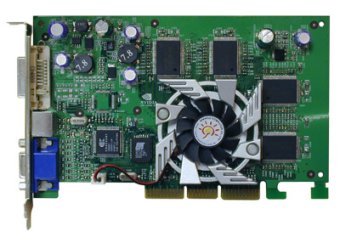
Clock Speeds: 250MHz Core, 400MHz Memory
350Mhz RAMDAC - supports resolutions up to 2048x1536x16bpp @ 75Hz (32bpp @ 60Hz)
AGP4X with Fast Writes
TV-Out
64Mb 128-bit DDR memory
Next, the Prolink PixelView GeForce2 Ti
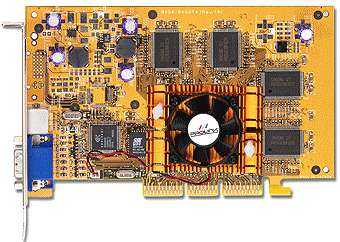
Clock Speeds: 250Mhz Core, 444Mhz Memory
AGP4X with Fast Writes
TV-Out
64Mb 128-bit DDR memory
As you can see, sharing the same GPU core, same memory size and both sporting TV-Out, the boards are very similar. The only thing to differentiate these boards is the memory speeds. Remember that NVIDIA's official speed is 250/400 which the Sparkle runs at, we'd expect the Prolink to take the performance lead given its slightly higher memory clock.
Performance Introduction
Being a card review you wont be barraged with Sandra's theoretical benchmarks for a change, just plenty of game results. Here's the test system and the software we'll be using.
Test System:
- Shuttle AV40R VIA P4X266 Socket 478 Motherboard
- Intel 1.7GHz Pentium 4 Processor w/ Stock Intel Retail Cooler
- 256Mb Crucial PC2100 CAS2.5 (@CAS2) DDR
- Adaptec 39160 PCI SCSI Dual Channel U160 controller
- 2 x 73Gb Seagate Cheetah U160 10,000rpm SCSI disks
- Plextor 12/10/32S SCSI CDRW
- Creative 12x IDE DVD
The 1.7 P4 and P4X266 board is a mid range P4 system these days. Comparatively speaking, it's around as fast as a 1500XP and fast DDR chipset if you are an AMD owner.
Test Software:
- Windows XP Professional Build 2600.xpclient.010817-1148
- DetonatorXP 22.40 NVIDIA drivers
- Quake3 v1.30 (four.dm_66 demo)
- Unreal Tournament 436 (Thunder demo)
- Aquamark v2.36
- 3DMark 2001 Professional
XP was installed without a problem on the Shuttle and it includes VIA drivers for the chipset. Test games were installed without a hitch and patched up if need be (Quake3 only, UT is 436 from the beginning being G.O.T.Y Edition). We'll visit stock performance first and overclocked performance to conclude.
Stock Performance
Quake3 is our sole OpenGL benchmark from the group of 4. It doesn't take advantage of programmable shaders or any DX8 class features. It runs very well on GF2 class hardware as long standing GTS owners will tell you and the GF2 Ti's with their hybrid Pro/Ultra clocks should do very well. Resolutions tested were 1024x768, 1280x1024 and 1600x1200, all at 32bit colour, 32bit textures and all performance sapping rendering options turned on.
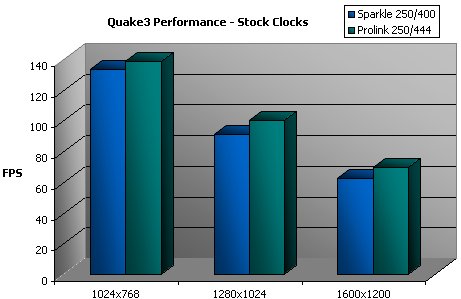
The Prolink, due to it's slightly higher memory clock takes the lead here. The real thing to notice here is that in the first 2 resolutions, the average framerates are very high and very playable, even with all the rendering options turned up to their fullest. Even without a GF3/R8500, running these supposed 2nd tier cards, the Quake3 performance is excellent. It's getting on a bit now, but the rendering engine is still top notch and still knows how to stress some cards.
Next up, we have our pre-DX8 DirectX benchmark, Unreal Tournament. Like Quake3 it doesn't use DX8 class features and has been around for a bit now. Framerates in Unreal Tournament are influenced a lot by CPU speed rather than the graphics clocks due to the amount of time the UT engine spends doing actor calculations and lighting and it's all done on CPU. However it lets us see how the still popular game runs on this class of card.

The Prolink again takes a very slight lead in UT due to its ever so slight memory clock advantage. Remember that's the only thing the defines the two cards uniquely. Everything else is static and it shows just how far a manufacturer will go to gain the advantage, in this case overclocking the card from the factory. While running UT benches, the benchmark plays at game speed, not speeded up to run as fast as possible as you see in Quake3. While watching both cards run the Thunder demo there wasn't really any hint of slowdown, except maybe at 1600x1200 and then, very little. These cards were are DX7 cards in essence and it's no surprise they both well here. A win for Prolink but it's very close.
Third in our list is Aquamark. Aquamark is a new benchmark here at Hexus and relies heavily on DX8 class hardware, especially in the pixel shader to extract the best performance. Being pre-DX8, the GF2 Ti's on display here don't do as well as a DX8 class card in this benchmark. For simple reference, a GF3 Ti500 running on NVIDIA's nForce board scored 45.8fps.
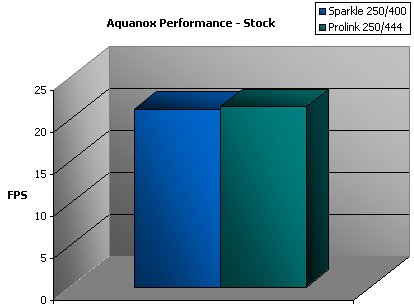
Less than half the score of a DX8-class card is to be expected. Aquanox is pixel shader heavy and relies on a card that implements the features it needs to run well. Aquamark is also framerate stable meaning that throughout the benchmark the framerate didn't deviate much from the final result scores.
Finally we have 3DMark 2001. Like Aquamark it makes use of DX8 features like the pixel and vertex shader and it has a special test, Nature, for that class of cards. Nature is a heavy points scorer for cards that can run it.
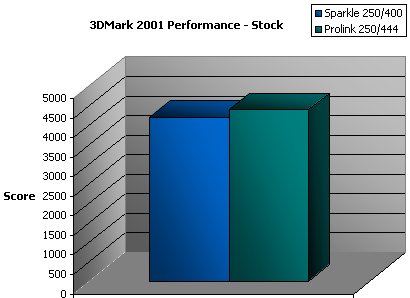
The Prolink again takes the lead here due to its higher clocks which isn't surprising. Close on 4500 from the Prolink and not far behind from the Sparkle are both good scores considering the hardware and test platform. Being able to run Nature is a real boon for your 3DMark scores if you are a tweaker so the cards drop behind here, but near 4500 from the stock bench is very respectable.
So out of the box performance on the test platform is very respectable, especially in the older benchmarks, Quake3 and UT where the game engines don't require the use of the advanced features that the cards simply don't support. For the newer marks, they lag behind a little but nothing too serious. The test platform is fairly powerful so remember to scale things up or down to suit. Also remember that we run the test at resolutions of 1024x768 and up. 800x600 will boost things considerably and it's still a very playable resolution.
Overclocked Performance
With both cards being so similar in specification, I guess it was no surprise that overclocking the cards gave very similar results. Overclocking was done until I found the maximum stable speed at which the card could loop the High Detail Dragothic test in 3DMark 2001 (the hardest test in the benchmarks I ran for NVIDIA cards to do) without rendering artifacts of any kind. Any rendering error was noted and the card backed down until the maximum stable clock was found.
Both cards have rather small heatsinks on the core GPU and no heatsinks on the memory chips. Application of heatsinks, especially to the memory chips would give better results most likely and the GF2 processor loves memory bandwidth so the higher the memory clock the better.
The maximum overclocked speed of the Prolink was a slightly low 266/466. I was expecting more, especially after seeing the clock speeds of some recent Gainward Ti450's, another GF2 Ti card which I've seen running much higher (300+/500+). The Sparkle was ultimately quicker, but the clock speed of 267/468 is for all intents and purposes identical. Here are the benchmark results.

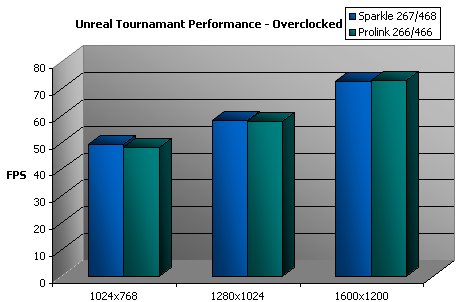
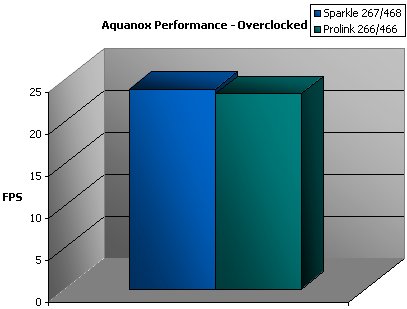
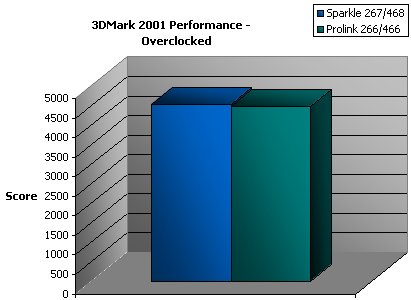
In each case, a performance improvement of around ~2/3% was achieved. For the card clocks obtained this is exactly what was expected. The increases were modest and slightly disappointing. I was quite surprised the final clocks were as they were and I was expecting a bigger increase from both cards and a bigger spread. As you can see, overclocked performance was identical and the Sparkle takes the lead in most marks due to the ever so slightly higher clocks.
As a side note, the Sparkle was able to go a fair bit higher than the Prolink ultimately at the expense of rendering errors. Before locking up entirely the Sparkle made it to 277/480 whereas the Prolink didn't manage much more than its final stable clocks at 271/470. Therefore the Sparkle seems to be the card to go for in terms of overclocking potential. Both cards seem to be ripe for modifying with better cooling solutions. Not quite factory supported and it will void your warranty but it wouldn't hard to do and the Sparkle should respond well. Remember that the test system ran no board side cooling so all the heat removal was done by the card fan on the GPU.
Features and Bundles
Both cards featured TV-Out ports and both looked fine on my television with a max resolution of 800x600 on both cards. The bundles of both cards contained just the bare essentials. A TV-Out cable and driver CD was all that was contained in both boxes, along with the cards as you can see in the following pictures. Additionally, the SP6600Ti was bundled with a copy of Cyberlink PowerDVD for DVD playback on the host system.
Prolink Pixelview GeForce2 Ti
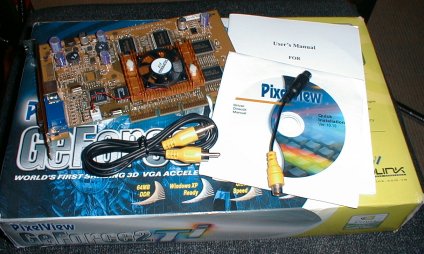
Sparkle SP6600Ti
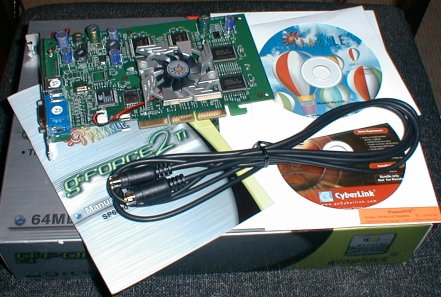
Conclusion
The out of the box performance from both cards was very good. The test platform was fairly modest with a midrange P4 processor and DDR chipset giving the cards a decent base from which to perform. They certainly aren't GF3's or R8500's by any stretch of the imagination but then again they aren't priced to compete with those cards. They are 2nd tier cards from NVIDIA for the gamer on a budget or the tactical upgrader looking for a card to tide him over until the next big thing. Looking at it like that, competing on price with the other GeForce2 Ti's and ATi's Radeon 7500 card which can all be found at around £115-£130 in the UK, the two test cards do very well. They offer better performance than the 7500 at the expense of features so it's up to you to decide what you need from the card and purchase wisely.
As tactical upgrades they cant be beaten. The cost is so cheap that you'd be silly not to pick up a GeForce2 Ti if you were desperate for a card but wanted to hedge your bets on the current pinnacle of consumer graphics or simply needed to save a few hard of your hard earned dollars or pounds.
The Radeon 7500 is still a decent choice given HydraVision and the DVD playback quality however on performance, each of these cards would beat it soundly.
Excellent little cards and hopefully we can see more of them at Hexus and in the UK in the future.
|